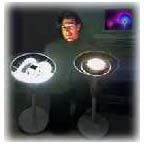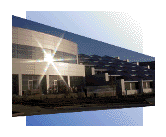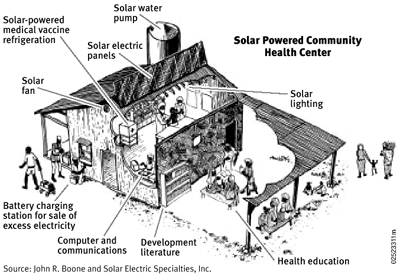|

The National Renewable Energy
Lab
View NREL Letter
to Greenstar
View Department of Energy Letter
to ASE and Greenstar
As the nation's leading center for renewable energy research,
NREL is developing new energy technologies to benefit both the
environment and the economy.
Environment.
The production and use of conventional, fossil-fuel based energy
accounts for 95 percent of all air pollution and $50 billion
in U.S. health care costs every year. In contrast, clean energy
sources such as sunlight and wind can be harnessed to produce
electricity, process heat, fuel and valuable chemicals with little-if
any-pollution. Sunlight also can be harnessed for tasks such
as cleaning up contaminated soil and groundwater.
Energy.
There's no shortage of renewable energy resources. North Dakota
has enough wind to supply 35 percent of the total U.S. electricity
demand. The sunlight falling on the United States in one day
contains more than twice the energy we consume in an entire year.
Fast-growing plants and geothermal are other self-renewing resources
awaiting the right technologies for harvesting. Continued research
will ensure that these technologies are efficient, reliable and
affordable.
Economy.
America now imports more than half its oil at a cost of $52 billion
annually. New energy technologies based on indigenous, self-renewing
resources will help keep these dollars at home to strengthen
the economy and create as many as a 300,000 new jobs for American
workers. And, they will give U.S. companies a competitive edge
in the $400-billion-a-year global market for "green"
goods and services.
 Origins. Origins.
The National Renewable Energy Laboratory (NREL) was established
by the Solar Energy Research Development and Demonstration Act
of 1974. Originally called the Solar Energy Research Institute,
NREL began operating in July 1977 and was designated a national
laboratory of the U.S. Department of Energy in September 1991.
Twenty years of research have yielded remarkable progress
in many renewable energy technologies. The cost of wind energy
has declined from 40¢ per kilowatt-hour to about 5¢.
Photovoltaic systems can now be manufactured for about $2.20
per watt, down from $4.50 per watt in 1980. And ethanol costs
have plummeted from $4 per gallon in the early 1980s to $1.22
today.
With guidance and funding from the U.S. Department of Energy,
NREL researchers will continue to improve efficiencies and lower
costs to competitive levels. NREL also is working with utilities,
state regulatory agencies, the World Bank and international trade
groups to make sure that renewable energy technologies reach
the marketplace as quickly as possible.
Mission.
NREL's mission is to lead the nation toward a sustainable energy
future by developing renewable energy technologies, improving
energy efficiency, advancing related science and engineering
and facilitating commercialization.
Management.
NREL is a national laboratory owned by the U.S. Department of
Energy and managed by the Midwest Research Institute of Kansas
City, Mo.
Research Programs.
Almost 50 areas of scientific investigation include photovoltaics,
wind energy, biomass-derived fuels and chemicals, energy-efficient
buildings, advanced vehicles, solar manufacturing, industrial
processes, solar thermal systems, hydrogen fuel cells, superconductivity,
geothermal and waste-to-energy technologies. Many of NREL's research
achievements have been ranked among the nation's most significant
technical innovations by R&D Magazine, Discover, and Popular
Science.
Funding. NREL's operating budget for fiscal year 1997
was about $158 million. About 93 percent of NREL's funding comes
from the U.S. Department of Energy's Office of Energy Efficiency
and Renewable Energy, with the remainder from sources such as
grants and cost-shared research with industry. NREL has contributed
more than $27.3 million to cost-shared research agreements, with
U.S. companies and universities providing another $67.7 million.
Staffing.
NREL employs about 800 researchers, engineers, analysts and administrative
staff. An additional 200 to 300 visiting professionals, graduate
students, interns and leased workers can be found at NREL's main
campus at various times throughout the year.
 Facilities. Facilities.
NREL's 300-acre campus is located at the foot of South Table
Mountain in Golden, Colo. Major research facilities include:
Solar Energy Research Facility-photovoltaics, superconductivity
and materials science
Field Test Laboratory Building-alternative fuels, biomass-derived
chemicals and
genetic engineering
Thermal Test Facility-buildings research and energy efficiency
Photovoltaic Outdoor Test Facility
Alternative Fuels User Facility and Process Development Unit
Solar Furnace and Solar Radiation Research Laboratory
National Wind Technology Center (north of Golden)
Industry Partnerships:
About 45 percent of NREL's funding returns directly to the private
sector through subcontracts, cost-shared research agreements
and procurements. NREL awarded $104 million in subcontracts and
procurements in FY 1997. Research partners include more than
70 universities, 250 companies, 25 state energy offices and 80
not-for-profit organizations. NREL's progressive business practices
have been honored by the Small Business Administration, Minority
Enterprises Inc. and the Federal Laboratory Consortium.
For more information:
NREL
1617 Cole Blvd.
Golden, Colorado 80401-3393
Main Number: (303) 275-3000
Energy Efficiency & Renewable Energy Clearinghouse (EREC)
1-800-363-3732
The U.S. DOE's Office of Energy Efficiency and Renewable Energy
provides free general information and technical and business
assistance through EREC.
Request information by phone or by mail: P.O. Box 3048, Merrifield,
VA 22116; fax: 1-703-893-0400; e-mail: doe.erec@nciinc.com;
or through the World Wide Web at: http://www.eren.doe.gov/consumerinfo/.
In September 1998, the National Renewable Energy Lab issued
a report on the use of solar and other alternative energy sources
as part of an overall health program in developing countries.
The report echoes much of Greenstar's mission; in fact, it details
a how a solar community center might be designed for village-level
deployment that is parallel in many ways to the Greenstar system.
The full report is available here; "Renewable
Energy for Rural Health Clinics." Here is a concept
design image from this paper:

The complete report is approx. 850K, in PDF
format; requires Adobe Acrobat. If you don't have this free program,
download it at http://www.adobe.com.
Greenstar is proud to collaborate closely with NREL in deploying
our programs.
|

 Origins.
Origins.  Facilities.
Facilities. 